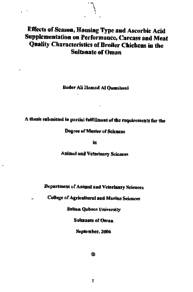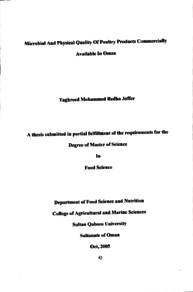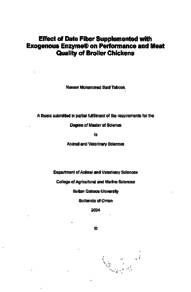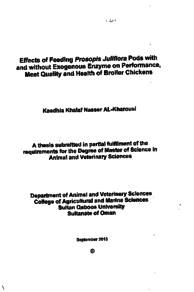وثيقة
Effects of season, housing type and ascorbic acid supplementation on performance, carcass and meat quality characteristics of broiler chickens in the Sultanate of Oman
الناشر
Sultan Qaboos University
ميلادي
2006
اللغة
الأنجليزية
الموضوع
الملخص الإنجليزي
ABSTRACT
A study was conducted to investigate the effects of season, housing type and ascorbic acid supplementation on performance, carcass and meat quality characteristics of commercial broiler chickens under Omani conditions. Two houses (closed and open-sided houses) and four levels of ascorbic acid (000, 100, 200 and 300-ppm) were used in the cool and hot season experiments whereas one house (open-sided house) and four levels of ascorbic acid (000, 100, 200 and 300-ppm) were used in the mild season experiment. Four-hundred
and thirty two day-old Cobb-500 broiler chickens were randomly and equally divided into open-sided house and closed house. Within each house, birds were randomly allocated into four treatments with six replicates each containing nine birds. In the mild season experiment, 216 birds were randomly allocated into four treatments with six replicates each containing nine birds. Daily minimum and maximum temperatures for outside and inside houses and relative humidity readings were recorded. Weekly rectal temperatures, rnortality rate, feed intake, weight gain and feed conversion ratio in broiler chickens were measured. At the end of the experimental period (42 days), two birds from each pen were
randomly selected and slaughtered to evaluate the effect of housing type and ascorbic acid supplementation on carcass and meat quality characteristics. There were large differences in the range of ambient temperatures between hot, cool and mild season experiments; (32-45°C), (22-28°C) and (25-35°C), respectively. Temperature inside the closed house was not affected by these seasonal changes because of the efficient cooling system. On the other hand, the open-sided house was much affected by the ambient temperature and relative humidity outside the house especially during hot season. This resulted in. appearance of heat stress classical signs in birds such as panting and wing lifting during the hot season.
Rectal temperatures in control birds in the open-sided house during hot season (40.3-42.5°C) were significantly (p<0.05) higher than those in cool season (40.1 41.5°C) and mild season (40.7-41.4°C). Control birds significantly (p<0.05) consumed 12.8 and 12.2% less feed in the hot season than their counterparts in the cool and the mild seasons, respectively. Similarly, body weight gain was 15.7 and 17.0% less in the hot season than in the cool and the mild season, respectively. Ascorbic acid supplementation improved broiler performance,
carcass and meat quality characteristics with the effect been more pronounced in the hot season. Feed intake was improved by 6.6, 28.7 and 3.6% with 300 ppm ascorbic acid supplementation in the cool, hot and mild seasons, respectively. Body weight gain was also improved by 7.0, 29.0 and 7.3% with 300-ppm ascorbic acid supplementation added in the cool, hot and mild seasons, respectively. On the other hand, mortality rate was reduced; carcass and meat quality characteristics were improved by supplementing ascorbic acid during hot season. This study indicated that supplementing ascorbic acid will be beneficial to small-scale farmers in the open-sided house type under Omani conditions during the hot season of the year.
المجموعة
URL المصدر
الملخص العربي
خلاصة
أجري هذا البحث لدراسة تأثير الفصل ونظام الإيواء وفيتامين سي (حمض الأسكوربيك) في الدواجن اللاحمة على الإنتاجية ومواصفات الذبيحة وجودة اللحم وذلك تحت الأجواء المناخية في سلطنة عمان. في تجربتي الفصل البارد والحار تم إستخدام نوعان من المساكن أحدهما مفتوح يعتمد على التهوية الطبيعية والأخر مقفول مع تحكم كامل بدرجة الحرارة مع اربعة مستويات مختلفة من الفيتامين في كل منهما وهي (000، 100، 200 و 300 جزء من المليون). أما في تجربة الفصل المعتدل فقد تم إستخدام نوع واحد وهو المسكن المفتوح مع أربعة مستويات مختلفة من الفيتامين (000، 100، 200 و 300 جزء من المليون). تم إستجلاب أربعمائة وإثنان وثلاثون صوص عمر يوم واحد من عترة كوب 500 و توزيعها عشوائيا في كل مسكن إلى أربع مجموعات حسب مستويات الفيتامين المستخدمة بحيث تحتوي كل مجموعة على ست مکررات في كل مكرر 9 طيور. تم إستخدام نصف هذا العدد في تجربة الفصل المعتدل نظرا لأن التجربة تم إجراءها في مسكن واحد فقط. تم أخذ درجات الحرارة الدنيا والعليا و درجات الرطوبة في المسكنين بشكل يومي وبمعدل ثلاث قراءات خلال فترات الصباح والظهيرة والليل. تم قياس درجة حرارة الجسم عن طريق الشرج بشكل أسبوعي إضافة إلى تسجيل معدل النفوق معدل استهلاك الطعام ومعدل نمو الوزن ومعامل التحويل الغذائي. في نهاية التجربة التي استمرت 42 يوما تم اختيار طائرين من كل مكرر بشكل عشوائي وذبحهما وذلك لتقييم تأثير نظام الإيواء والفيتامين في مواصفات الذبيحة وجودة اللحم. كانت هناك إختلافات في درجات الحرارة بين الفصول الثلاثة بالنسبة المسكن المفتوح (32-45 درجة مئوية في الفصل الحار) ، ( 28 - 22 درجة مئوية في الفصل البارد) و (25-35 درجة مئوية في الفصل المعتدل). لم تتأثر درجات الحرارة داخل البيت المغلق بدرجات الحرارة في الخارج بينما تأثر البيت المفتوح وخصوصا في فصل الصيف بدرجات الحرارة في الخارج. وقد أدى ذلك إلى ظهور علامات الإجهاد الحراري على الطيور خلال الصيف في البيت المفتوح. كانت درجة حرارة الجسم في طيور مجموعة التحكم داخل البيت المفتوح أعلى في الفصل الحار (40. 3 إلى 42. 5 درجة مئوية) عن مثيلاتها في الفصل البارد (40. 1 إلى 41. 5 درجة مئوية) والفصل المعتدل (40. 7 الى 41. 4 درجة مئوية). إستهلكت طيور مجموعة التحكم داخل البيت المفتوح علفة أقل في الفصل الحار عن مثيلاتها في الفصل البارد والمعتدل بنسبة 12. 8 % و 12. 2 % على التوالي، وجد أيضا أن معدل النمو في نفس المجموعات قد إنخفض في الفصل الحار عن مثيلاتها في الفصل البارد والمعتدل بنسبة 15. 7 % و 17. 0 % على التوالي. برهنت هذه الدراسة أن إضافة حمض الأسكوربيك قد حسن إنتاجية الطيور ومواصفات الذبيحة وجودة اللحم وبخاصة في الفصل الحار. إرتفع استهلاك العلف بنسبة 6. 6 %، 28. 7 % و 3. 6 % مع إضافة 300 جزء من المليون في تجارب الفصل البارد ، الحار والمعتدل على التوالي. كما تحسن معدل النمو مع إضافة 300 جزء من المليون من حمض الأسكوربيك بنسبة 70% ، 29. 0 % و 7. 3 % في الفصل البارد ، الحار والمعتدل على التوالي. وفي نفس الوقت إنخفضت نسبة النفوق وتحسنت مواصفات الذبيحة وجودة اللحم مع إضافة حمض الأسكوربيك وخصوصا في تجربة الفصل الحار. أثبتت هذه الدراسة أن أضافة حمض الأسكوربيك إلى مياه الشرب يحسن أداء الطيور ويمكن أن يكون ذو فائدة إنتاجية لصغار مربي الدواجن وخاصة للتربية في البيوت المفتوحة في فصل الصيف في السلطنة.
أجري هذا البحث لدراسة تأثير الفصل ونظام الإيواء وفيتامين سي (حمض الأسكوربيك) في الدواجن اللاحمة على الإنتاجية ومواصفات الذبيحة وجودة اللحم وذلك تحت الأجواء المناخية في سلطنة عمان. في تجربتي الفصل البارد والحار تم إستخدام نوعان من المساكن أحدهما مفتوح يعتمد على التهوية الطبيعية والأخر مقفول مع تحكم كامل بدرجة الحرارة مع اربعة مستويات مختلفة من الفيتامين في كل منهما وهي (000، 100، 200 و 300 جزء من المليون). أما في تجربة الفصل المعتدل فقد تم إستخدام نوع واحد وهو المسكن المفتوح مع أربعة مستويات مختلفة من الفيتامين (000، 100، 200 و 300 جزء من المليون). تم إستجلاب أربعمائة وإثنان وثلاثون صوص عمر يوم واحد من عترة كوب 500 و توزيعها عشوائيا في كل مسكن إلى أربع مجموعات حسب مستويات الفيتامين المستخدمة بحيث تحتوي كل مجموعة على ست مکررات في كل مكرر 9 طيور. تم إستخدام نصف هذا العدد في تجربة الفصل المعتدل نظرا لأن التجربة تم إجراءها في مسكن واحد فقط. تم أخذ درجات الحرارة الدنيا والعليا و درجات الرطوبة في المسكنين بشكل يومي وبمعدل ثلاث قراءات خلال فترات الصباح والظهيرة والليل. تم قياس درجة حرارة الجسم عن طريق الشرج بشكل أسبوعي إضافة إلى تسجيل معدل النفوق معدل استهلاك الطعام ومعدل نمو الوزن ومعامل التحويل الغذائي. في نهاية التجربة التي استمرت 42 يوما تم اختيار طائرين من كل مكرر بشكل عشوائي وذبحهما وذلك لتقييم تأثير نظام الإيواء والفيتامين في مواصفات الذبيحة وجودة اللحم. كانت هناك إختلافات في درجات الحرارة بين الفصول الثلاثة بالنسبة المسكن المفتوح (32-45 درجة مئوية في الفصل الحار) ، ( 28 - 22 درجة مئوية في الفصل البارد) و (25-35 درجة مئوية في الفصل المعتدل). لم تتأثر درجات الحرارة داخل البيت المغلق بدرجات الحرارة في الخارج بينما تأثر البيت المفتوح وخصوصا في فصل الصيف بدرجات الحرارة في الخارج. وقد أدى ذلك إلى ظهور علامات الإجهاد الحراري على الطيور خلال الصيف في البيت المفتوح. كانت درجة حرارة الجسم في طيور مجموعة التحكم داخل البيت المفتوح أعلى في الفصل الحار (40. 3 إلى 42. 5 درجة مئوية) عن مثيلاتها في الفصل البارد (40. 1 إلى 41. 5 درجة مئوية) والفصل المعتدل (40. 7 الى 41. 4 درجة مئوية). إستهلكت طيور مجموعة التحكم داخل البيت المفتوح علفة أقل في الفصل الحار عن مثيلاتها في الفصل البارد والمعتدل بنسبة 12. 8 % و 12. 2 % على التوالي، وجد أيضا أن معدل النمو في نفس المجموعات قد إنخفض في الفصل الحار عن مثيلاتها في الفصل البارد والمعتدل بنسبة 15. 7 % و 17. 0 % على التوالي. برهنت هذه الدراسة أن إضافة حمض الأسكوربيك قد حسن إنتاجية الطيور ومواصفات الذبيحة وجودة اللحم وبخاصة في الفصل الحار. إرتفع استهلاك العلف بنسبة 6. 6 %، 28. 7 % و 3. 6 % مع إضافة 300 جزء من المليون في تجارب الفصل البارد ، الحار والمعتدل على التوالي. كما تحسن معدل النمو مع إضافة 300 جزء من المليون من حمض الأسكوربيك بنسبة 70% ، 29. 0 % و 7. 3 % في الفصل البارد ، الحار والمعتدل على التوالي. وفي نفس الوقت إنخفضت نسبة النفوق وتحسنت مواصفات الذبيحة وجودة اللحم مع إضافة حمض الأسكوربيك وخصوصا في تجربة الفصل الحار. أثبتت هذه الدراسة أن أضافة حمض الأسكوربيك إلى مياه الشرب يحسن أداء الطيور ويمكن أن يكون ذو فائدة إنتاجية لصغار مربي الدواجن وخاصة للتربية في البيوت المفتوحة في فصل الصيف في السلطنة.
قالب العنصر
الرسائل والأطروحات الجامعية




